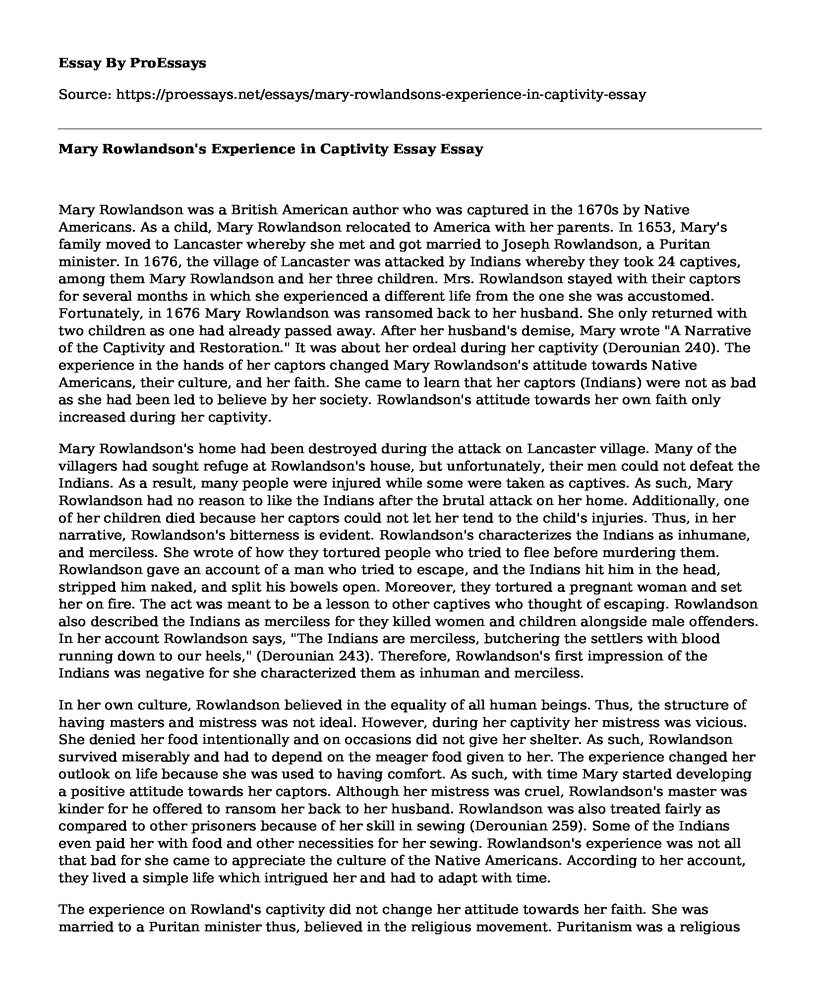Mary Rowlandson was a British American author who was captured in the 1670s by Native Americans. As a child, Mary Rowlandson relocated to America with her parents. In 1653, Mary's family moved to Lancaster whereby she met and got married to Joseph Rowlandson, a Puritan minister. In 1676, the village of Lancaster was attacked by Indians whereby they took 24 captives, among them Mary Rowlandson and her three children. Mrs. Rowlandson stayed with their captors for several months in which she experienced a different life from the one she was accustomed. Fortunately, in 1676 Mary Rowlandson was ransomed back to her husband. She only returned with two children as one had already passed away. After her husband's demise, Mary wrote "A Narrative of the Captivity and Restoration." It was about her ordeal during her captivity (Derounian 240). The experience in the hands of her captors changed Mary Rowlandson's attitude towards Native Americans, their culture, and her faith. She came to learn that her captors (Indians) were not as bad as she had been led to believe by her society. Rowlandson's attitude towards her own faith only increased during her captivity.
Mary Rowlandson's home had been destroyed during the attack on Lancaster village. Many of the villagers had sought refuge at Rowlandson's house, but unfortunately, their men could not defeat the Indians. As a result, many people were injured while some were taken as captives. As such, Mary Rowlandson had no reason to like the Indians after the brutal attack on her home. Additionally, one of her children died because her captors could not let her tend to the child's injuries. Thus, in her narrative, Rowlandson's bitterness is evident. Rowlandson's characterizes the Indians as inhumane, and merciless. She wrote of how they tortured people who tried to flee before murdering them. Rowlandson gave an account of a man who tried to escape, and the Indians hit him in the head, stripped him naked, and split his bowels open. Moreover, they tortured a pregnant woman and set her on fire. The act was meant to be a lesson to other captives who thought of escaping. Rowlandson also described the Indians as merciless for they killed women and children alongside male offenders. In her account Rowlandson says, "The Indians are merciless, butchering the settlers with blood running down to our heels," (Derounian 243). Therefore, Rowlandson's first impression of the Indians was negative for she characterized them as inhuman and merciless.
In her own culture, Rowlandson believed in the equality of all human beings. Thus, the structure of having masters and mistress was not ideal. However, during her captivity her mistress was vicious. She denied her food intentionally and on occasions did not give her shelter. As such, Rowlandson survived miserably and had to depend on the meager food given to her. The experience changed her outlook on life because she was used to having comfort. As such, with time Mary started developing a positive attitude towards her captors. Although her mistress was cruel, Rowlandson's master was kinder for he offered to ransom her back to her husband. Rowlandson was also treated fairly as compared to other prisoners because of her skill in sewing (Derounian 259). Some of the Indians even paid her with food and other necessities for her sewing. Rowlandson's experience was not all that bad for she came to appreciate the culture of the Native Americans. According to her account, they lived a simple life which intrigued her and had to adapt with time.
The experience on Rowland's captivity did not change her attitude towards her faith. She was married to a Puritan minister thus, believed in the religious movement. Puritanism was a religious movement that beseeched to cleanse the Church of England. Rowlandson's captivity account provides insights into the elements of puritanism. In her narrative, Rowlandson believes that God offers protective powers, punishes backsliders, redeems, and works through the scriptures (Derounian 253). As such, Rowland believed that her troubles in the hands of her captives were a way of God testing her faith. According to her faith, she also believed that her race was more superior to that of the Native Americans. Rowlandson's belief is un-Christian like, but she believed in the Puritans. Rowlandson's faith did not subside for she owned a Bible that she read and compared to the puritans thinking. After her release, she said that it an act of God and not that of her rescuers.
Conclusion
In conclusion, Rowlandson's account explores the life of Native Americans and their culture. Consequently, she gives details of how the experience changed her religious views. During the 16th and 17th centuries, Puritanism was a popular religious movement in England. Mary Rowlandson explores elements of puritanism and how it helped her survive her eleven weeks in captivity. Rowlandson cannot be blamed for her religious views for it was a result of her society. More so, her attitude towards Native Americans was as a product of her upbringing, but over time she became more appreciative of their culture.
Work Cited
Derounian, Kathryn Zabelle. "The Publication, Promotion, and Distribution of Mary Rowlandson's Indian Captivity Narrative in the Seventeenth Century." Early American Literature 23.3 (1988): 239-261.
Cite this page
Mary Rowlandson's Experience in Captivity Essay. (2022, Aug 23). Retrieved from https://proessays.net/essays/mary-rowlandsons-experience-in-captivity-essay
If you are the original author of this essay and no longer wish to have it published on the ProEssays website, please click below to request its removal:
- Sociology Essay Example: The Nativists and Immigration
- Essay Sample on War and Conflict in Syria
- Cyrus the Great and the Cyrus Cylinder Essay
- A Magnificent Catastrophe - Literary Analysis Essay
- Essay Example on Famous Figures of Modernity: Charles Darwin
- Essay Example on Comparing WWI & WWII: Causes & Effects on Global History
- Essay Sample on A History of Rights in the US: African-Americans and Women







